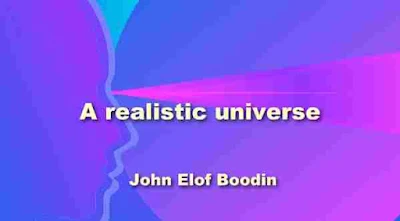A realistic universe
This attitude which the author has been championing for several years is an attempt to apply the scientific method to philosophic problems. The term pragmatic is used in the sense which was first advocated by C. S. Peirce, and which is defined by the author in his own terms in "Truth and Reality."
As applied to metaphysics the pragmatic method means that we must judge the nature of reality, in its various grades and complexities, by the consequences to the realization of human purposes, instead of by a priori assumptions. Some may prefer the older adjectives of "empirical" or "critical", but these terms seem definitely associated with certain historical doctrines, and a new term seems to be preferable in designating the scientific tendency of today.
There is a need in every age of retranslating the perennial problems of philosophy into terms of living human interest; the author hopes in a measure to further this movement at the present time through these volumes. In "A Realistic Universe" the author has tried to make vital the fundamental problems of metaphysics in terms of our present thought-world, without the cant of the past, but with a deep sense of indebtedness to the masters of all time.
While the book is intended primarily for the philosophic student, the aim has been to make the style as clear and simple as the problems would permit. In the use of scientific material, an effort has been made to find sources that would be intelligible to the layman rather than to make an appearance of erudition. Some portions, such as the introductory chapter and part five on Form, may be of special interest to the general reader.
The present work does not aim to be a compendium of current literature. There are books that serve this purpose in an admirable way. It must be judged rather as a personal reaction to the permanent problems of human experience, for, whether we will it or no, our systems are after all personal reactions. If they are sincere and thorough, we may hope that they will further the total movement of truth.
The time seems peculiarly auspicious for such an attempt at synthesis. While there has been much suggestion and inspiration in a recent discussion, the constructive efforts have been disappointing. This is due, no doubt, to the magnitude of the task. In the complexity of modern thought and life, we cannot perhaps hope for an Aristotle. What could once be accomplished by in- dividual genius, must now be carried out piecemeal by the inner stimulation and supplementation of a collective mind.
The author will be satisfied if he can count as even an infinitesimal part in this infinite task. As this work has grown up for the most part on the western prairies, may it reflect the homely sanity of the great West.
Contents:
Part I. Energy And Things
Being Matter And The Absolute . . . 15-32
Pragmatic Energism 33-61
Do Things Exist? 62-73
Knowing Things 74-91
Knowing Things (Continued) 92-112
Part 2 Consciousness And Mind
The Concept Of Consciousness .... 115-133
The Concept Of Consciousness (Continued) . . 134-150
Knowing Minds 151-163
Knowing Minds (Continued) 164-190
Individual And Social Minds 191-204
Part 3. Space And Reality
Psychological And Geometric Space . . . 207-224
The Nature Of Real Space . . 225-247
Part 4 Time And Reality
The Nature Of Time 251-282
Time And The Problematic 283-303
Table Of Contents
Part 5 Form And Reality
The Identity Of The Ideals .... 307-325
Form And The Ought 326-359
Teleological Idealism 360-384
Retrospect The Five Attributes . . . 385-404
John Elof Borodin was a Swedish-born American philosopher and educator. He was the author of numerous books proposing a systematic interpretation of nature. Boudin's work preserved the tradition of philosophical idealism within the framework of contemporary science
- Author: John Elof Borodin.
- Publication date: 1916
Download A realistic universe - 17 MB - PDF ebook


